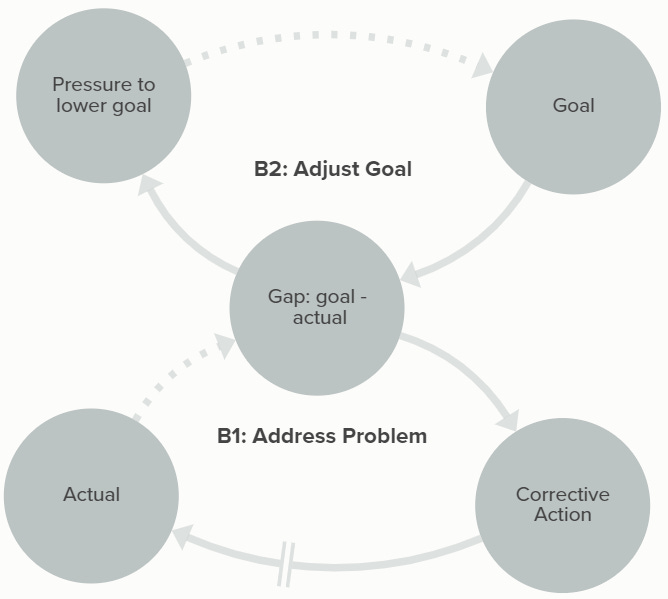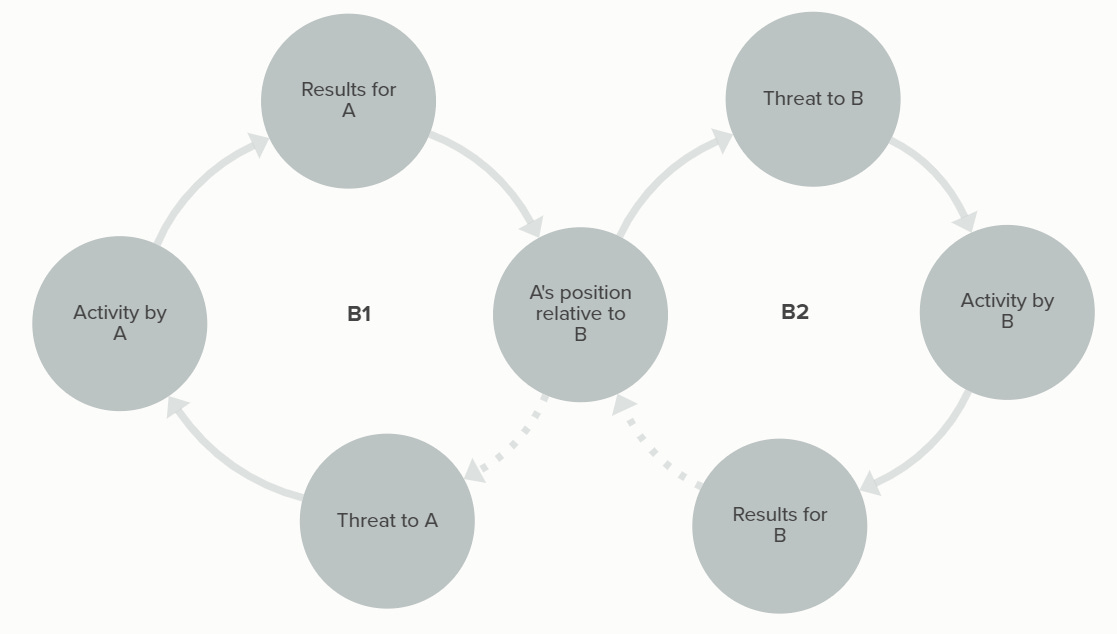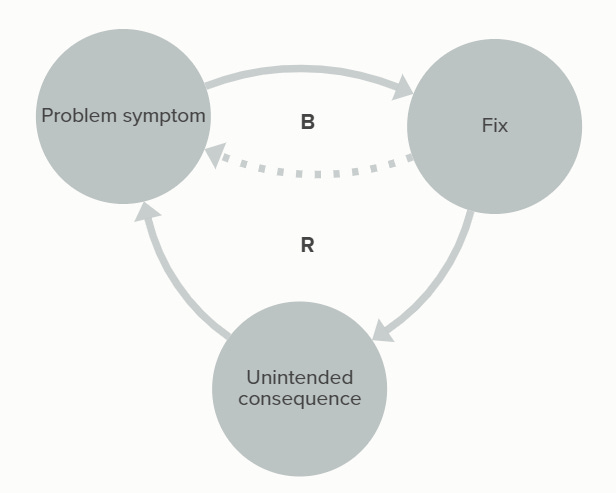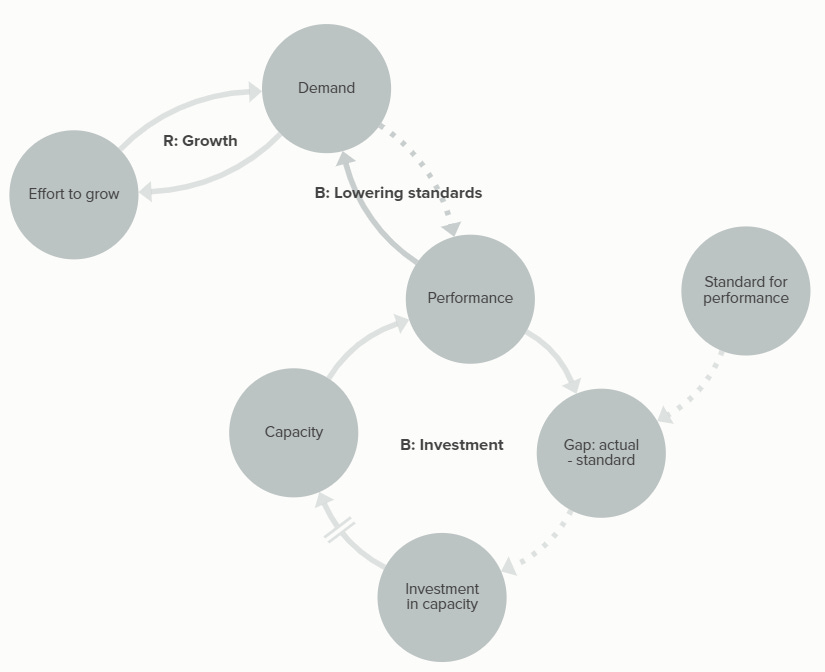Have you ever been in a situation (family, work, etc) where the same problem comes up again and again, despite good-faith, sensible efforts to improve?1 If so, you may have been witnessing how a bad system can thwart the best intentions.
Now that we have the two primal archetypes of systems enumerated (reinforcing and balancing loops), we can combine them to tell more complicated stories. Because so many of these describe common patterns of dysfunction in human organizations, it’s helpful to collect and describe them in a general way, so the pattern can be recognized in real-world problems. The following archetypes come from two articles by Pegasus Communications, whose great resources are compiled at The Systems Thinker website2 and which go into much more detail than what I’m able to present here. They present 8 archetypes in total, and I’m breaking them up between this week and next.
Drifting Goals
This is pretty similar to a balancing loop with a goal: the more the actual value falls short of the goal, the more pressure there is to take meaningful action to increase the actual. This (eventually) increases the actual value, reducing the gap. However, the time and difficulty of making the corrections means that some of that pressure is diverted toward lowering the goal/standard itself, which is a faster way to close the gap. This makes me think of parenting: it’s so much harder to keep the kids in the habit of cleaning the dining room after dinner than to let it slide, or just clear the table but not sweep the floor, etc. One other place this frequently shows up is when strict safety standards exist to prevent a rare incident3; corners can be cut and nothing bad may happen for a while, leading to a cultural lack of concern until something terrible happens.
What’s the fix once this is recognized? The system diagram itself suggests a couple of suggestions: remove the delay from the corrective action by finding a better standard process, or make the goal impervious to pressure by fixing it to something externally defined. Either way, creating a compelling vision and a plan to make the goal something the actors in the system are willing to work toward.
Escalation
This archetype comes from perceptions of threat between two parties in competition (A and B in the diagram above). The actions of one party are seen as threatening by the other, who increases effort in order to regain or maintain dominance. This is the story of arms races, price wars, and (part of) why restaurants are so loud. It’s an interesting demonstration of how two balancing loops can combine to create a single reinforcing loop (because each has an odd number of opposite connections, the aggregate has an even number).
There are a few potential fixes here. If the measurement of relative position is leading to the escalation (for example, simple price on a good with other relevant quality/brand dimensions), maybe the whole thing can be avoided. If delays in the system are making it hard to judge the competitive position and leading to lots of precautionary competition, reducing the delay (maybe by getting data with less latency) can contain the problem. Last, if there’s a broader shared goal or framework that both parties can cooperate on, it can serve to balance this competitive tendency4.
Fixes that Fail
The idea here is that a quick/obvious solution to a problem directly alleviates the symptoms, but also causes unintended consequences that mute or reverse the improvement. As an example, when I’m at a conference I’m usually tired from traveling, sleeping in a new bed, the inescapable realities of sitting in a room and listening for hours, etc. I’m often tempted to stay awake by grabbing whatever food they have available (often cookies or something similar), which will give me a bit of a temporary lift but in the long run make me even sleepier as my insulin spikes5. The trick with this archetype is to find the deeper solution, which in this specific case is probably to go easier on the simple carbs during the day, and make sure that you’ve thought through potential side effects (such as indigestion).
Growth and Underinvestment
This archetype is the most complicated so far, containing three loops. In the first, growth is the result of some work put in: sales efforts, advertising, etc. However, the growth in demand leads to strain in the system: imagine new orders overwhelming a tiny fulfillment department, etc. In the long run, the solution to this is to invest in capacity that matches the growth in demand, allowing for a consistent level of service. However, because of this delay, the performance degrades, which dampens the growth in demand. That can look like a lack of potential for growth, and justify a lack of investment. In more extreme cases, the system’s limits are reached while waiting for the increased capacity and the moment of growth opportunity passes; this is a common story for startups that can’t scale fast enough or don’t have enough in reserves. In class we constructed an example of a musician enjoying early success, but filling time with concerts can make it difficult to maintain the same level of novelty/innovation6, and making the sacrifices to spend more time in the studio instead of actively generating income by touring.
Many of the potential solutions directly address this delay as the source of the problem: see if there’s a way to speed up how fast new capacity can come online, or find data that helps you anticipate the rise in demand faster. Even just being aware of how investment is affecting the level of quality can help avoid the “self-fulfilling prophecy” nature of this pattern.
That’s all for today - look for more patterns next week. In the meantime, I’d love to hear your examples for these archetypes.
If not, please adopt me.
Note that the orientation of some of my loops is different than Pegasus because Kumu draws all arrows going clockwise. [Edit: this is not correct; it isn’t the default and it just wasn’t obvious to me how to change it]
This doesn’t have to be as dramatic as surgery checklists or NASA protocols; a goal of not using your phone while driving could follow this pattern as well.
Of course, this cooperation isn’t always desirable for society as a whole - laws against collusion exist specifically to make sure that businesses continue to compete for the benefit of consumers.
Or require me to eat a steady stream of snacks, which tends to make me feel pretty terrible afterward.
Often leading to second album syndrome.





